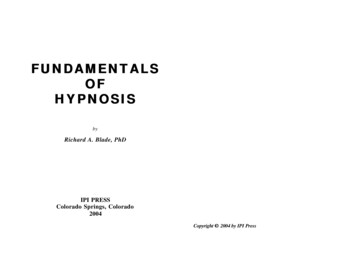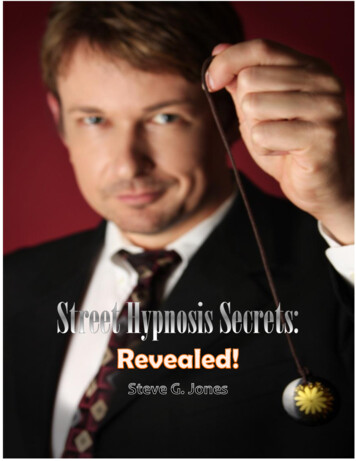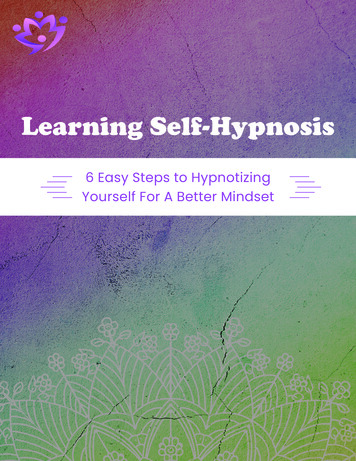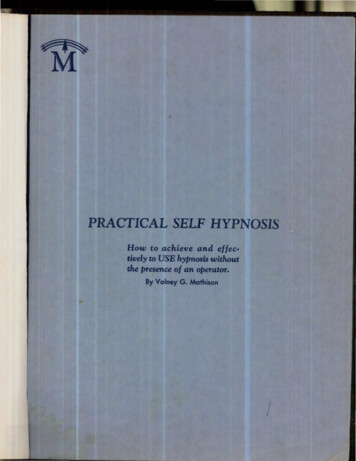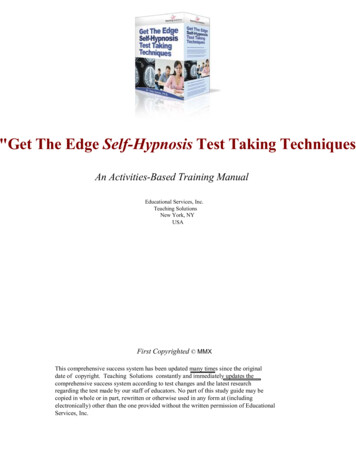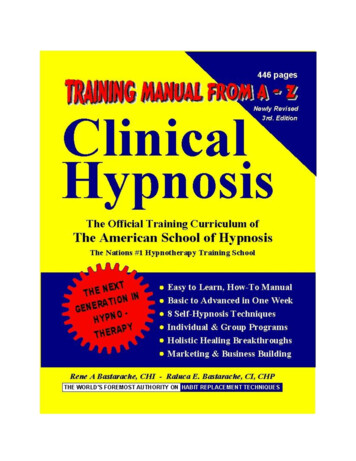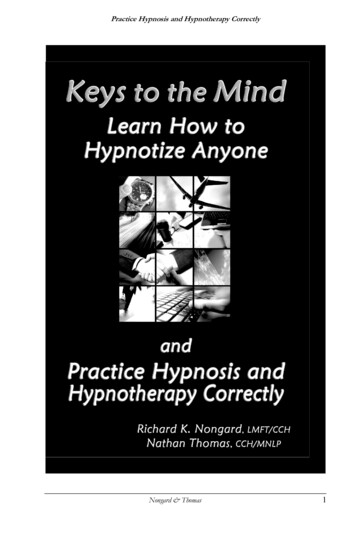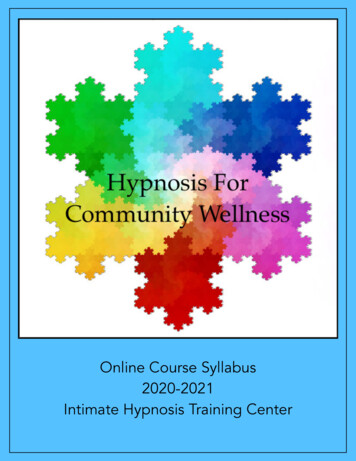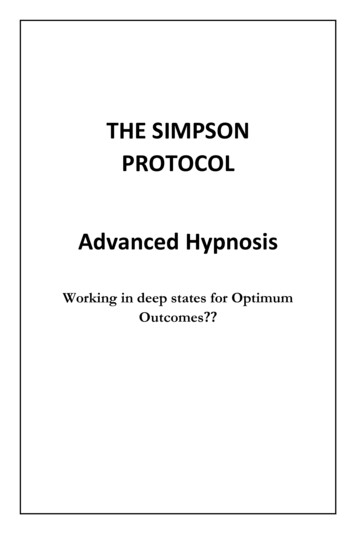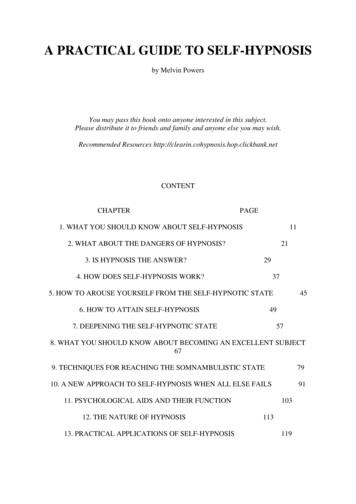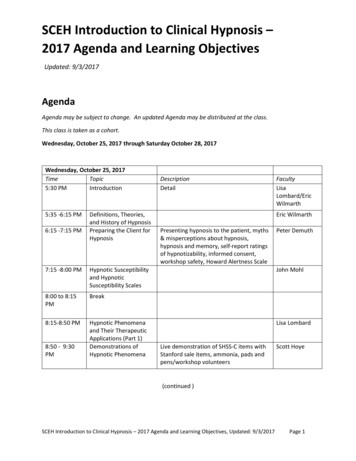
Transcription
SCEH Introduction to Clinical Hypnosis –2017 Agenda and Learning ObjectivesUpdated: 9/3/2017AgendaAgenda may be subject to change. An updated Agenda may be distributed at the class.This class is taken as a cohort.Wednesday, October 25, 2017 through Saturday October 28, 2017Wednesday, October 25, 2017TimeTopic5:30 PMIntroduction5:35 -6:15 PM6:15 -7:15 PMDefinitions, Theories,and History of HypnosisPreparing the Client forHypnosis7:15 -8:00 PMHypnotic Susceptibilityand HypnoticSusceptibility Scales8:00 to 8:15PMBreak8:15-8:50 PMHypnotic Phenomenaand Their TherapeuticApplications (Part 1)Demonstrations ofHypnotic Phenomena8:50 - arthEric WilmarthPresenting hypnosis to the patient, myths& misperceptions about hypnosis,hypnosis and memory, self-report ratingsof hypnotizability, informed consent,workshop safety, Howard Alertness ScalePeter DemuthJohn MohlLisa LombardLive demonstration of SHSS-C items withStanford sale items, ammonia, pads andpens/workshop volunteersScott Hoye(continued )SCEH Introduction to Clinical Hypnosis – 2017 Agenda and Learning Objectives, Updated: 9/3/2017Page 1
SCEH Introduction to Clinical Hypnosis – 2017 Agenda and Learning ObjectivesThursday,October 26, 2017Time9:30 - 10:00 AM10:00 -10:15 AM10:15 - 10:45 AM10:45 to 11:45 AMTopicPrinciples of HypnoticInduction and ReAlerting I: The Processof HypnosisBREAKDescriptionpositive expectations, fix attention,manage resistance, pace, deepen, lead,suggest, realertFacultyTom RostafinskiPrinciples of HypnoticInduction and ReAlerting II: InductionTechniquesSupervised Small GroupPractice (FIRST)Explanations & demonstrations ofrelaxation inductions, ideomotorinductions, eye fixation, visualization, etc.To be announcedParticipants will practice hypnoticinduction and re-alertingTom Rostafinski11:45 to 12:45 PMPrinciples in Formulating Principles of direct and indirectHypnotic Suggestions Isuggestions12:45 to 1:45 PMLUNCH1:45 to 2:45 PMHypnotic Deepening andTrance Ratification2:45 to 3:15 PM3:15 PM3:30 -4:30 PM4:30-5:30 PMDepth and stages of hypnosis. Methods ofdeepening hypnotic involvement. TranceratificationSupervised Small Group Participants will practice crafting andPractice (SECOND) delivering suggestions for eliciting eachPrinciples in Formulating hypnotic phenomenonHypnotic Suggestions IIBreakTreatment Planning(Strategy and TechniqueSelection) & Strategiesfor Managing Resistanceto HypnosisHypnosis for PainControlEvelyn SegalDave SmithTo be announcedSteve KahnDave Patterson(continued )SCEH Introduction to Clinical Hypnosis – 2017 Agenda and Learning Objectives, Updated: 9/3/2017Page 2
SCEH Introduction to Clinical Hypnosis – 2017 Agenda and Learning ObjectivesFriday, October 27, 2017TimeTopic8:30 AMSelf-Hypnosis: What it isand How to Teach it toClientsDescriptionFacultySteve KahnParticipants will practice inducinghypnotic analgesia and anesthesiaDave Patterson,etc.9:15 AMSupervised Small GroupPractice (THIRD)10:15 to 10:30amBREAK10:30 AMHypnotic RelaxationTherapyThe use of hypnosis for stressmanagement & anxietyGary Elkins11:15Cognitive BehavioralApplications of HypnosisIntegration of hypnosis into CBT.Discussion of examples such as habitdisorders, phobia, & depressionDon Moss/ GaryElkins11:45 am to12:45 pmLunch Break12:45 PMMedical Applications ofHypnosis1:45 PMIdeometer Signaling forUnconscious Exploration2:30 PMSupervised Small GroupPractice (FOURTH)3:15 PMBreak3:30 PMEricksonian Approachesto HypnosisMolly Delaney4:00 -5:00 PMEthics, ProfessionalConduct, andCertificationKEYNOTE: David SpiegelTom Nagy5:00-6:00 PMDabney EwinPsychodynamic applications of hypnosis.Discussion of examples such as somaticdisruption treatment-resistantpsychological symptoms.participants will practice the use ofideomotor signalingDabney EwinTrance Formation: Hypnosis in Brain andBody(continued )SCEH Introduction to Clinical Hypnosis – 2017 Agenda and Learning Objectives, Updated: 9/3/2017Page 3
SCEH Introduction to Clinical Hypnosis – 2017 Agenda and Learning ObjectivesSaturday October 28, 2017TimeTopic8:30 AMHypnosis & the Media9:30-10:30Clinical ApplicationsAM(Part 2)10:20-10:30Workshop Wrap up, Q &AMADescriptionInterviews, myths, etc.Family therapy, memory retrieval, end oflife issues, etc.FacultyEric WilmarthEric WilmarthEric Wilmarth/Lisa Lombard,etc.Learning Objectives1. Define hypnosis based on current published definitions of hypnosis.2. Identify at least three major figures in the historical development of hypnosis3. Identify at least three major theories of hypnosis.4. Identify the major myths and misconceptions regarding hypnosis5. Identify three possible changes associated with hypnosis and memory.6. Discuss specific ethical/legal issues involving hypnotic restoration of memories, disqualification oftestimony in court, and the “false memory” syndrome.7. Cite three key points of hypnosis in a non-technical manner in educating a client or patient abouthypnosis.8. Summarize two or more important elements in obtaining informed consent regarding the use ofhypnosis clinically.9. Identify at least five phenomena associated with hypnosis and how they may be utilized in clinicalpractice and treatment planning.10. Summarize at least two reasons for removing suggestions and for re-alerting clients; anddemonstrate at least one method for re-alerting from hypnosis.11. Define at least six principles of hypnotic induction and suggestion.12. Demonstrate a hypnotic induction and provide a therapeutic suggestion to a volunteer client.13. Participate in at least three separate hypnotic experiences as subject and as facilitator.(continued )SCEH Introduction to Clinical Hypnosis – 2017 Agenda and Learning Objectives, Updated: 9/3/2017Page 4
SCEH Introduction to Clinical Hypnosis – 2017 Agenda and Learning Objectives14. Cite evidence for the long-term stability of hypnotic responsivity and be able to identify the agerange when hypnotic responsiveness peaks15. List the traditional "stages of hypnosis"16. Describe at least four traditional methods for deepening or intensifying hypnotic involvement.17. Be capable of teaching self-hypnosis to patients/clients18. Differentiate when one might use a suggestive hypnotic approach and when an insight-oriented orexploratory hypnotic approach might be appropriate.19. Identify therapist, patient, and context variables that may contribute to resistance.20. Identify the ethical-legal issues and standards for professional conduct in using hypnosis clinically.21. List the requirements for certification through the Society for Clinical and Experimental Hypnosis,and for the American Society of Clinical Hypnosis.SCEH Introduction to Clinical Hypnosis – 2017 Agenda and Learning Objectives, Updated: 9/3/2017Page 5
Learning Objectives 1. Define hypnosis based on current published definitions of hypnosis. 2. Identify at least three major figures in the historical development of hypnosis 3. Identify at least three major theor
